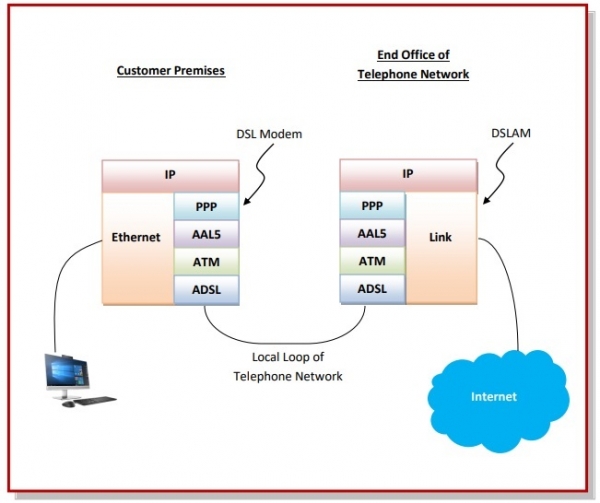
 Data Structure
Data Structure Networking
Networking RDBMS
RDBMS Operating System
Operating System Java
Java MS Excel
MS Excel iOS
iOS HTML
HTML CSS
CSS Android
Android Python
Python C Programming
C Programming C++
C++ C#
C# MongoDB
MongoDB MySQL
MySQL Javascript
Javascript PHP
PHP
- Selected Reading
- UPSC IAS Exams Notes
- Developer's Best Practices
- Questions and Answers
- Effective Resume Writing
- HR Interview Questions
- Computer Glossary
- Who is Who
ADSL protocol stacks
Asymmetric Digital Subscriber Line (ADSL) is a type of broadband communications technology that transmits digital data at a high bandwidth over existing phone lines to homes and businesses.
ADSL protocol stack depicts the set of protocols and devices that are used along with ADSL.
In order to access ADSL, a Digital Subscriber Line modem (DSL modem) is installed at the customer site. The DSL modem sends data bits over the local loop of the telephone network. The local loop is a two − wire connection between the subscriber’s house and the end office of the telephone company. The data bits are accepted at the end office by a device called Digital Subscriber Line Access Multiplexer (DSLAM).
Working Principle
In the customer site, IP packets are sent to the DSL modem using a link layer like Ethernet. The DSL modem transmits the data through the local loop of the telephone network to the DSLAM at the end office. The DSLAM extracts the IP packets and sends them over the Internet.
The protocols start at the physical layer with ADSL. Above it are the protocols ATM (Asynchronous Transfer Mode) and AAL5 (ATM Adaptation Layer 5). At the top of the stack, just below the IP is PPP (Point − to − Point) Protocol.
The following diagram shows the ADSL protocol stack −


